As another week of Bordeaux 2020 en primeur releases draws to a close, the campaign has begun to show signs of speeding up, with some compelling releases entering the market over the past three days.
Below we examine releases from Laroque (Wednesday 19th), Lafon-Rochet (Thursday 20th), and Branaire-Ducru and Batailley (Friday 21st).
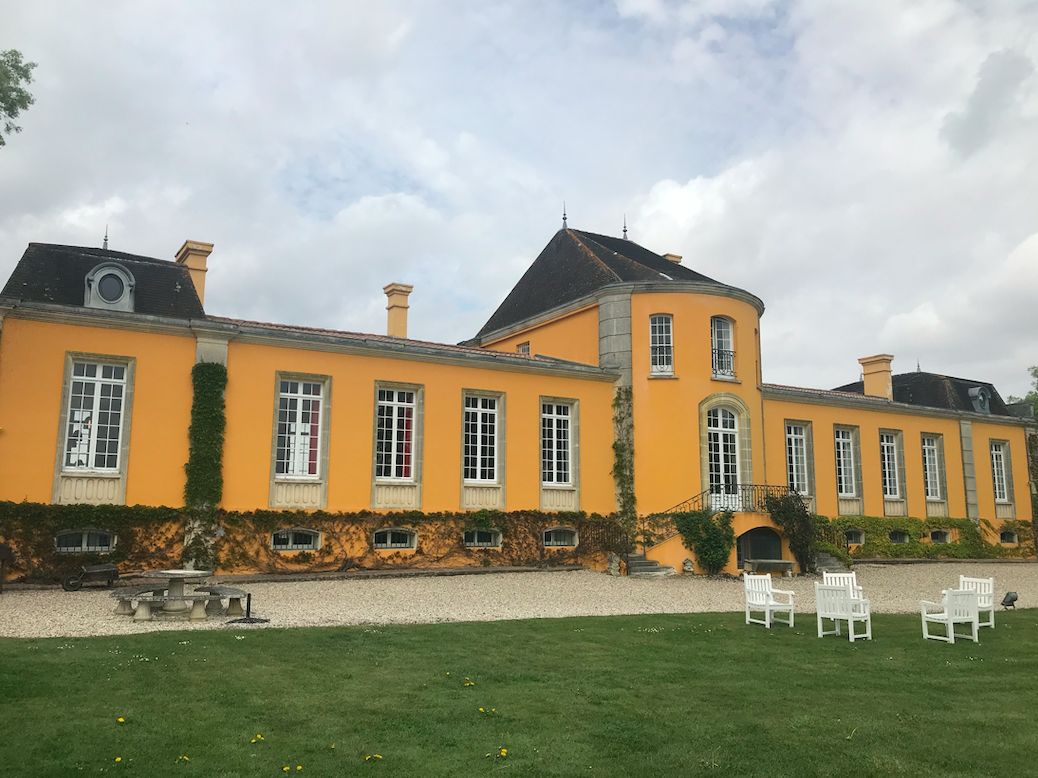 Lafon-Rochet’s latest release is a “very successful 2020”, according to Wine Lister partner critic, Jancis Robinson
Lafon-Rochet’s latest release is a “very successful 2020”, according to Wine Lister partner critic, Jancis Robinson
Released at £18.95 per bottle (in-bond), Laroque was described by Wine Lister CEO, Ella Lister as having an “ebullient, classy, very cassis nose”, developing into a “serious, structured wine on the palate”. The estate has seen recent improvements and investments to achieve a higher quality, starting with the hiring of David Suire in 2015, and the 2020 is no exception in the recent pattern of excellent value for money.
Lafon-Rochet’s latest vintage also illustrates the property’s upward quality trajectory. Having been awarded 17 points from Wine Lister partner critic, Jancis Robinson, (up from 16.5+ for the 2019) she describes it as a “very successful 2020” and congratulates owner, Basile Tesseron, for “producing something so appetising and groundbreaking”. Entering the market yesterday at c.£27.10 per bottle (in-bond), the vintage marks a year of development at Lafon-Rochet. As well as embarking on an agroforestry scheme in 2020 to enrich its environment, the latest release marks the inaugural collaboration of Jean-Claude Berrouet and Eric Boissenot, who worked together on its blending (recap our blog here). The price positioning of this top-quality vintage 10% below the 2019 market price has reportedly been very well-received.
Cru Classés Branaire-Ducru and Batailley were released this morning. Having made a name for itself as offering exceptionally good value within the Saint-Julien appellation, Branaire-Ducru’s latest release (at £31 per bottle in-bond) enters the market at an average 11% and 22% below than current availability of the 2019 and 2018 respectively.
Writing for JancisRobinson.com, James Lawther awards Batailley 2020 17 points, describing it as “Solid, subdued and distinctly Pauillac”. At c.£28 per bottle (in-bond), it enters the market under current average market prices of the last six vintages.
Keep track of en primeur releases on Wine Lister’s dedicated En Primeur Page here.
With the 2020 en primeur campaign now in full swing, the past two days have seen releases from the likes of Angélus, the Barton family, the Perse family, and more.
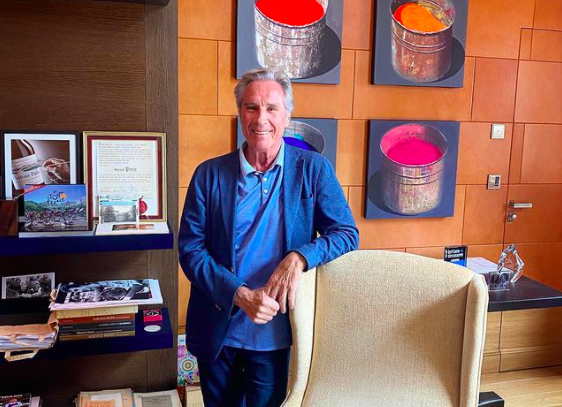 “Another big step in the right direction for this château in revealing its excellent terroir” – Wine Lister, CEO Ella Lister, who visited Pavie’s owner, Gérard Perse (pictured) last year
“Another big step in the right direction for this château in revealing its excellent terroir” – Wine Lister, CEO Ella Lister, who visited Pavie’s owner, Gérard Perse (pictured) last year
Released yesterday morning (Tuesday 18th May), the latest vintage of the Barton family wines – Léoville Barton, Langoa Barton, and Mauvesin Barton – has reportedly seen a positive uptake in the UK market already. Wine Lister partner critic, Jancis Robinson, gives high praise to the flagship release, Léoville Barton, awarding it 18 points, and noting that it shows “very fine winemaking indeed”, adding, “I have to admit I was tempted to swallow this, it was so majestic”. Wine Lister’s CEO, Ella Lister, also commends the latest vintage, describing a “sculptured structure which takes it into a different register”. The 2020 was released at £60.80 per bottle in-bond – over 10% higher than last year’s release, but potentially sporting the wine’s best quality to date.
Two more Saint-Émilion Grand Crus Classés “A” have joined fellow comrade and early-bird release Cheval Blanc, with Angélus entering the market at £254 per bottle (in-bond), and Pavie following closely behind at c.£241 per bottle (in-bond).
The latter gained resounding praise this year: James Lawther (for JancisRobinson.com) notes “absolute precision” which he says “more than highlights the change in style,” concluding, “one of the best yet”. Ella echoes this sentiment, asserting that “delightful floral freshness and a feather-light texture mark another big step in the right direction for this château in revealing its excellent terroir,” and calling the wine ”complex and refined”. The comments combined suggest that Pavie 2020 is the culmination of stylistic changes undertaken by the property over the last few years.
Perse family sibling, Pavie-Decesse 2020 was also released yesterday at £83 per bottle (in-bond). The latest vintage gains 17 points from James Lawther, who describes “Tension and minerality as well but plenty of charm this year”. With virtually no stocks of last year’s release remaining on the market, and the estate offering an element of rarity (at 3.5ha, it is a 10th of the size of Pavie), the latest release is likely to gain appeal beyond its volume released.
Also released so far this week are: Marquis d’Alesme, Labégorce, Coutet, Guiraud, Bellevue-Mondotte, and Monbousquet.
The Bordeaux en primeur 2020 campaign began in earnest last week, with Cheval Blanc the first of the major releases out of the gate. Its latest vintage was offered at a small, 3% increase on the 2019 release price, which itself came to market with a generous discount of c.30% on the previous year.
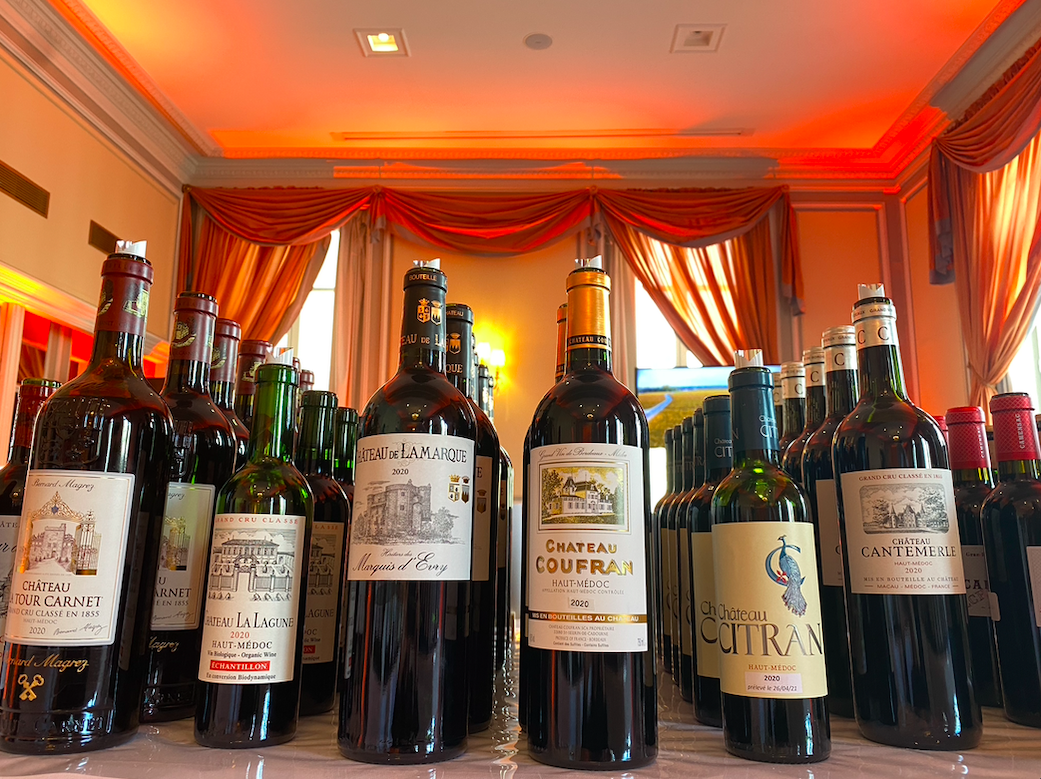 UGCB Tasting at The Intercontinental Hotel Bordeaux, attended by Wine Lister CEO, Ella Lister
UGCB Tasting at The Intercontinental Hotel Bordeaux, attended by Wine Lister CEO, Ella Lister
Absence makes the heart grow fonder
Much of the international trade has entered into a second consecutive year without the normal en primeur tasting week in situ. Instead, the bordelais have generally come up trumps with sending samples this year (only a very small handful of châteaux have declined to send any at all), and in many cases, one-on-one video calls have replaced the fleeting group tasting slots at the estates. Edouard Moueix, Managing Director of Etablissements Jean-Pierre Moueix observes how this has actually been a help, rather than a hindrance, in telling the story of the vintage to clients: “we can take time to explain things like we did some years ago”, he says. With a much wider range of tastings this year (albeit remotely for most) and a slightly less condensed campaign schedule, this should allow room for lesser-known wines that have excelled in the vintage to shine, where last year the sale of 2019s at lightning speed favoured well-known and trusted brands in the main.
While pricing is more often than not the hot topic for many participants in en primeur campaigns, sales of 2020 have the potential for focus on the great stories of each individual Bordeaux estate, given that the price equation this year is perhaps simpler than it has been in recent years.
Following a broadly successful “price reset” through the 2019 campaign, Bordeaux is holding all the cards that should ensure en primeur sales of 2020 work just as well (if not better), riding the wave of renewed interest in Bordeaux created last year. If 2019 prices set the precedent, then all that need happen now is to follow suit – matching last year’s release price, since the quality of 2020 for the majority of wines does the same. A healthier GBP-Euro exchange rate than existed last year should also help to keep price tags attractive, and choices for top-quality, excellent-value wines will hopefully be available in spades.
Follow Wine Lister’s en primeur analysis here on our blog, where we will be highlighting top picks from the 2020 vintage as they are released.
Recap Part I of our Bordeaux Study here for further analysis of en primeur pricing.
Cheval Blanc 2020 was one of the first key releases out of the gate for this year’s Bordeaux en primeur campaign yesterday.
Having tasted in Bordeaux last week, Wine Lister’s CEO, Ella Lister, hails the wine “restrained and profound” on the nose, with “dark, hypnotic fruit”. The palate, she says, is “straight-lined, mineral, mouth-watering and fresh”, with an “incredibly long, saline finish”. As one of her favourite wines of the vintage, she would potentially give it a perfect score.
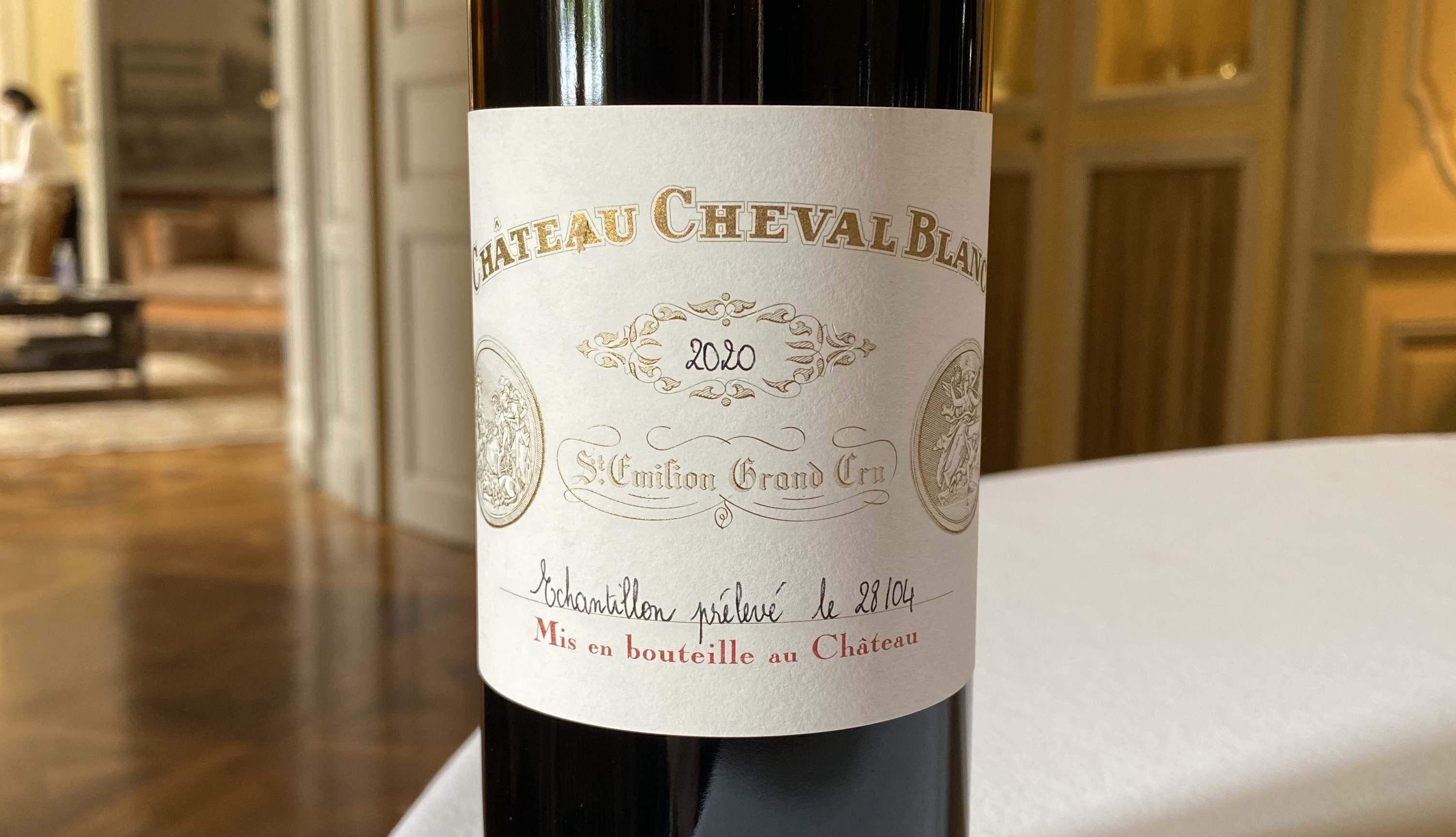
Technical Director, Pierre-Olivier Clouet notes that 2020 is cut quite differently from recent years at the estate. He characterises the vintage at Cheval Blanc in “three major waves”. First, the humid spring encouraged the vines to grow calmly and homogenously, accumulating water and nutrients much needed later in the season. The second wave was one of drought, which Clouet explains gives Cheval Blanc 2020 “a deep, tannic structure – dense but not hard, firm but not dry, ripe but not cooked”. Balancing this is Clouet’s “third wave” – a period of intense heat towards the end of the summer. With temperatures during harvest reaching 38-39 degrees Celsius, the hot spell translates into a very “expressive, intense, crisp, and aromatic nose”, and a freshness on the palate thanks to quick picking, within 20 days (half the usual duration).
Cheval Blanc 2020 was being offered by UK merchants at around £380 per bottle in-bond – 3% above the 2019 release price, but well under the price of any small remaining quantities of 2019 currently available on the British secondary market. Last year’s gesture on pricing was exceptionally well-received, and the 2020 will likely be no exception.
As Wine Lister enters its fifth year in business, we are excited to announce the addition of 650 new wines onto Wine Lister’s information hub. Thanks to scores from our trusted partner critics, prices through our official pricing partner, Wine Owners, and data measuring popularity, as determined by the number of searches on Wine-Searcher (Pro and Pro+ site only), website users can now discover Wine Lister scores, prices, and apply decision-making analysis tools to a broader range of fine wines. With the latest additions, our database now extends across 4,450 wines, and over 40,000 wine-vintages, providing further insight to inform wine investment choices and strategic solutions.
Below we examine the regional split of the additional wines, and take a closer look at some of the properties featured in the expansion.
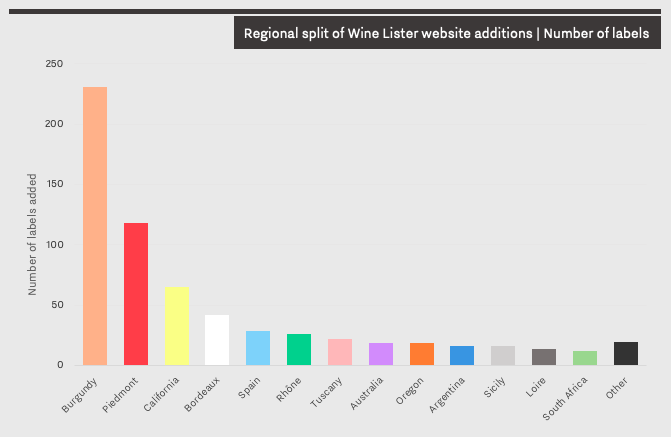
Burgundy represents 36% of the new selection, with more cuvées added from the likes of Pierre-Yves Colin-Morey, Cécile Tremblay, Benjamin Leroux, and more. A further 42 wines (6%) are added to the already-established set of Bordeaux properties featured on the Wine Lister site, including Cru Bourgeois Exceptionnels, Cambon La Pelouse, and Malescasse. Domaine des Roches Neuves represents seven out of the 10 new additions from the Rhône, alongside Bernard Baudry and Domaine du Closel.
Wine Lister’s Italian listings grow by 24% in the latest update, including 118 additions from Piedmont, 22 from Tuscany, and 16 from Sicily. The new Piedmontese picks include Arnaldo Rivera Barolo, Elvio Cogno, Figli Luigi Oddero, Giuseppe Mascarello e Figlio, and more. A region on the rise, Sicilian additions include new wines from organic Etna producers, Tenuta delle Terre Nere and Passopisciaro.
Wine Lister has also expanded its New World portfolio, which now features more additions from California (10% of the latest haul), Australia, and Oregon, among other regions. Featured amongst the new Californian picks are rising estates such as Littorai, Quintessa, Bevan, and Cardinale. Moving up the West Coast, Oregon additions include five new wines from Evening Land, four new bottles from Bergstrom, and three new picks from Antica Terra.
For more industry insights and advice on which wines and regions to buy, sign up for Wine Lister’s free newsletter here. Members of the trade can sign up to the Pro account to search and filter wines by Wine Lister Pro metrics.
Any of the producers recently added to the Wine Lister website can provide us with additional information on their wines, including production volumes, grape varieties, and label images. Email us at: team@wine-lister.com.
As the fine wine industry starts preparing for another Bordeaux en primeur season at a distance, Wine Lister has published Part I of its annual in-depth Bordeaux Study. With insights from key fine wine trade players from across the globe, Part I evaluates Bordeaux’s recent performance, considers the major takeaways from the 2019 vintage campaign, and contemplates the lessons they might provide moving forwards.
Please see our key findings below:
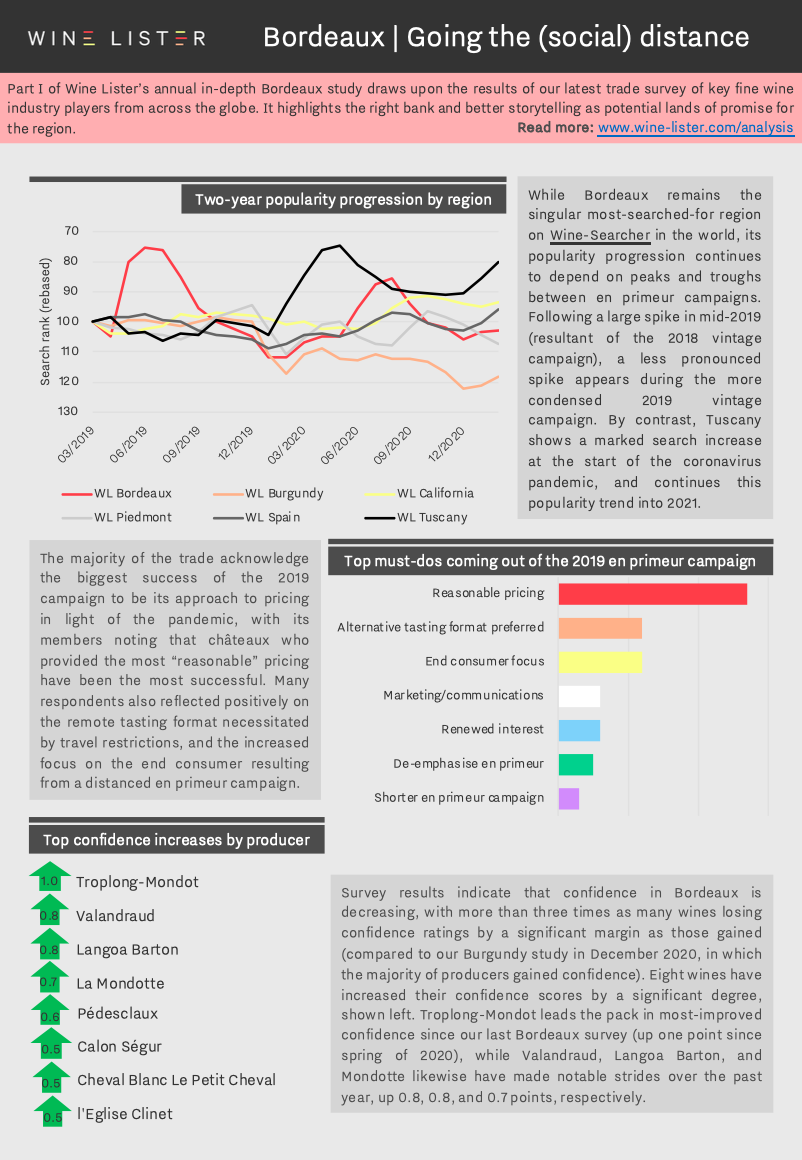
You can download the study digest in English here: Wine Lister 2021 Bordeaux Study – Digest or French here: Wine Lister 2021 Bordeaux Résumé d’étude. The full report can be purchased on our Analysis page, while Pro subscribers can access their free copy here.
With Bordeaux 2020 en primeur fast approaching, Wine Lister reports on one of the latest updates to emerge from the Médoc, informing your investment decisions over the coming months. In collaboration with Château Lafon-Rochet, we speak to Basile Tesseron to find out more about the inaugural partnership of two of the most revered consultants in Bordeaux to work on the estate’s 2020 blend: Jean-Claude Berrouet and Eric Boissenot.

Renowned for his expertise in Merlot production at Pomerol’s Château Petrus, Lafon-Rochet’s existing consultant, Jean-Claude Berrouet has been working at the estate alongside his son, Jeff, since 2012. Basile tells us that his team “admire the quality of the tannins present in the wines that Jean-Claude consults on, as well as his expertise with grapes coming from clay soils”.
With almost half of the estate based on clay, and the other half on dry, deep, gravely soils, he explains that “it was logical to combine Jean-Claude’s work with that of Eric Boissenot”, whose father, Jacques, has also been working with Lafon-Rochet for several years. With a reputation as oenologist to some of the Médoc’s top châteaux, Eric Boissenot is known for his dedication to the accentuation of terroir.
This meeting of minds from the Right and Left Banks for the first time illustrates another step in the evolution of Lafon-Rochet under Basile’s guidance. Since taking over the running of the estate in 2007, he has overseen the construction of two new cellars, extensive replanting, and a dedicated biodiversity programme. Having spent several years conducting agroforestry trials, last year Lafon-Rochet embarked on an agroforestry scheme that aims to make the estate wild once again through assisted natural regeneration. As well as installing bat nesting boxes and beehives, the property aims to plant 13,000 trees on its land by 2022.
Click here to sign up to Wine Lister’s free newsletter to keep track of everything en primeur over the coming months, including our recommendations on which releases to buy.
WL PR offers a dedicated communications service to help fine wine producers tell their story within the UK market. Head to our services page here to find out more.
With the bank holiday weekend approaching, Wine Lister has selected 10 mature Bordeaux MUST BUYs that promise to please with your Easter Sunday lunch. Boasting at least nine years of ageing, these top picks are available to purchase for under £100 (per bottle in-bond, when purchasing by the case in general).
Check out all of our Bordeaux MUST BUYs here, or read more below.
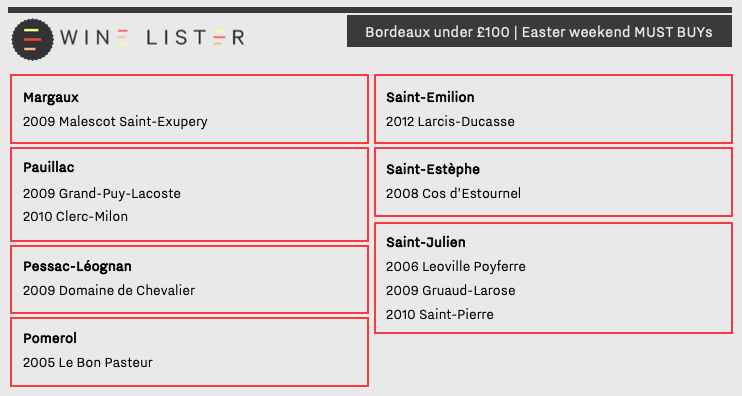
Regarded as a top-quality year for Bordeaux across appellations four of the 10 MUST BUY picks hail from 2009. Following a wet spring that provided plentiful water reserves, the summer of 2009 saw almost perfect growing conditions with minimal disease pressure, and many great wines from the vintage are beginning to either their optimum drinking window.
Described by Wine Lister partner critic, Jancis Robinson, as “very winning and opulent” with “massive volume and finish”, Margaux’s Malescot Saint-Exupery achieves a WL score of 93 in 2009. The property has exhibited an upward quality trajectory since the turn of the century, with the legendary Michel Rolland consulting on its production of a single, unfiltered and unfined wine. The 2009 vintage can be purchased from Fine+Rare for £71 per bottle (in-bond).
Grand-Puy-Lacoste’s 2009 vintage receives 18 points from Robinson, who notes; “a very sweet start. Herbal and interesting. Lots of fine tannin and savour. Very distinctive and ambitious”. Marking the estate’s highest WL score since its 1990 vintage (94), the 2009 is available to purchase from Bordeaux Index for £59 per bottle (in-bond).
Another classic left bank brand, Gruaud-Larose’s 2009 is described by Wine Lister partner critic, Neal Martin (Vinous), as offering refined aromas of “blackberry, cedar and leather”, and a “fine bead of acidity [with] great precision on the brown spice infused finish”. Hailed for the longevity of its wines, this can be enjoyed now, or aged for at least 10 more years. It is available from Bordeaux Index for £81 per bottle (in-bond).
Moving across to the right bank and back a few vintages, 2005 Le Bon Pasteur achieves the property’s highest ever WL score (94), and is described by Wine Lister partner critic, Bettane+Desseauve as offering notes of “dark fruits and fine chocolate”, and a “refined tannic structure, brilliant length and freshness”. With over 15 years of age, and only 2,500 bottles released, it has limited remaining market availability, but can be sought out for £100 per bottle (in-bond) from Cru World Wine.
Slightly south in Saint-Émilion, our chosen younger offering from Larcis-Ducasse – the 2012 – is available from Cult Wines for £41 per bottle (in-bond), making it the least expensive of the group. While rain in October forced many left bank estates to pick their late-ripening Cabernet Sauvignon earlier, the predominance of Merlot on the right bank saw its wines perform comparably better in 2012. Wine Lister partner critic, Jeannie Cho Lee, describes the 2012 Larcis-Ducasse as an “elegant, full bodied red with opulent tannins and wonderful energy”.
Last but not least, Saint-Estèphe star Cos d’Estournel makes the cut for its 2008 vintage. Robinson describes it as “very luscious and round” with a “strong blackcurrant element” and “surprisingly gentle tannins”. Achieving a WL score of 94, it is available to purchase by the bottle from Lay & Wheeler for £88 (in-bond).
To mark the first day of spring (Saturday 20th March), this week’s blog takes a deep dive into Wine Lister’s latest MUST BUY update, helping you to discover some excellent wines to enjoy over the next few months. The 19 new MUST BUYs cover a range of regions, varieties, and styles, providing inspiration for top picks to drink now or put away for the future.
Click here to view all MUST BUYs, or read more below.
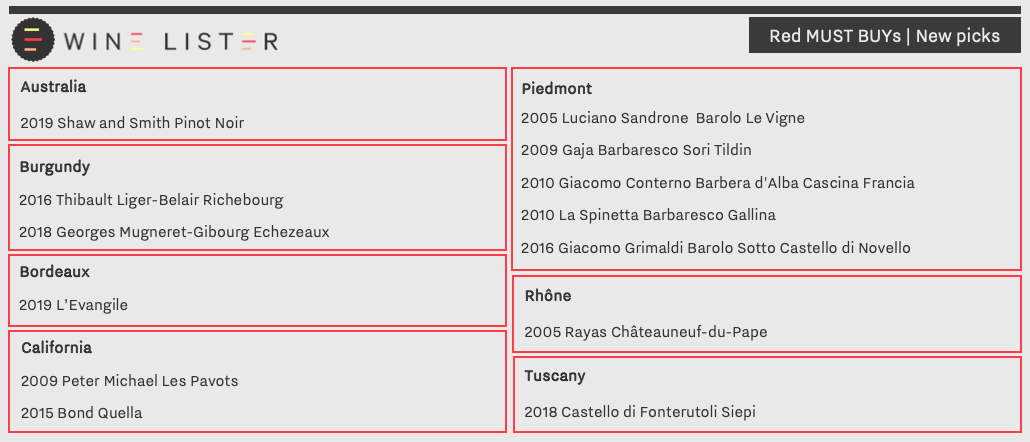
Piedmont constitutes over a quarter of the new MUST BUY picks, with entries from five of the region’s leading producers. Currently at its peak drinking, Luciano Sandrone’s 2005 Barolo Le Vigne comprises a blend of fruit from four of the estate’s top vineyards, each with different terroirs, altitudes, and exposures. Harvested, vinified, and aged separately, the final assemblage is intended to express the best characteristics of each plot. Wine Lister’s partner critic, Jancis Robinson, describes it as “complex”, with “already very integrated aromas”. It can be purchased from Farr Vintners for £79 per bottle (in-bond).
In Burgundy, Thibault Liger-Belair’s 2018 Richebourg achieves its highest WL score since the successful 2010 vintage (96), and is described by Wine Lister’s Burgundy specialist critic, Jasper Morris, as possibly “[Thibault’s] best Richebourg to date”. Awarding it 95-98 points, Jasper notes that “the oak […] is so suffused by a brilliant dense entirely red fruit, soft strawberry and more pronounced raspberry”. It is available to buy from Corney & Barrow for £450 per bottle (in-bond).
Representing the Southern Hemisphere, Shaw and Smith’s 2019 Pinot Noir also has Value Pick status, with a WL score of 92 at £26 per bottle (in-bond). The first vintage to include fruit from the property’s Lenswood vineyard, which boasts mature vines and high altitude, it marks an exciting development for Shaw and Smith. Richard Hemming for Jancis Robinson describes it at “superbly fragrant” and representative of “the sheer pleasure of the variety”. It can be bought from The Fine Wine Company.

Pierre-Yves Colin-Morey makes up two of three Burgundy whites to feature in the latest MUST BUY update, with its 2016 Meursault Perrières and 2018 Corton-Charlemagne. At £210 per bottle (in-bond), the former achieves 94 points from Jasper Morris, who notes “riper fruit, almost some orange blossom, but still an underlying freshness”. Meanwhile, Julia Harding for Jancis Robinson awards 19 points to the 2018 Corton-Charlemagne, describing it as “powerful and elegant” with a “smoky and quite subtle” nose. While both wines are more difficult to source, it is worth informing your merchant of your interest in purchasing them.
Other wines featured in the new MUST BUY selection are: 2005 Rayas Châteauneuf-du-Pape, 2009 Gaja Barbaresco Sori Tildin, 2009 Peter Michael Les Pavots, 2010 Giacomo Conterno Barbera d’Alba Cascina Francia, 2010 La Spinetta Barbaresco Gallina, 2014 Bouchard Père et Fils Montrachet, 2015 Bond Quella, 2016 Giacomo Grimaldi Barolo Sotto Castello di Novello, 2017 Gangloff Condrieu, 2017 Kistler Vineyards Hudson Vineyard Chardonnay, 2017 Kistler Vineyards McCrea Vineyard Chardonnay, 2018 Castello di Fonterutoli Siepi, 2018 Georges Mugneret-Gibourg Echezeaux, and 2019 l’Evangile.
Having commenced the week with International Women’s Day (Monday 8th March), Wine Lister’s latest blog celebrates some of the leading female figures in winemaking. Interviewing a handful of top producers across six regions, whose practices embody a range of principals, we put a spotlight on the wines made by some of the industry’s most exceptional women.
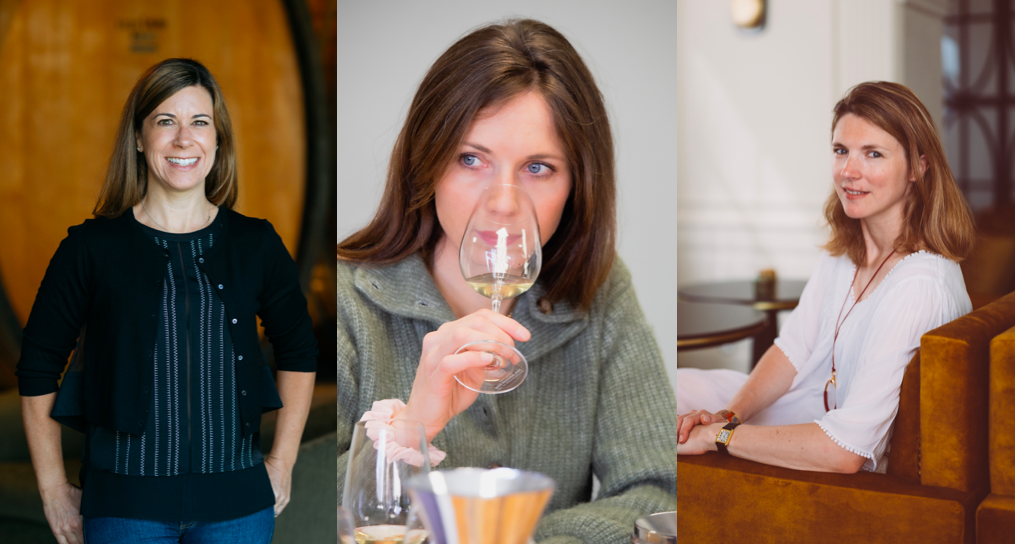 From left: Ashley Hepworth, Caroline Frey, and Stéphanie de Boüard-Rivoal
From left: Ashley Hepworth, Caroline Frey, and Stéphanie de Boüard-Rivoal
Ashley Hepworth – Joseph Phelps Vineyards
Following a degree in Chemistry and Biology, Ashley Hepworth spent two years cooking at Charlie Trotter’s legendary Chicago restaurant, where she realised she “wanted to learn more about wine and utilize [her] science background”. After studying the restaurant’s wines, and quizzing its Master Sommeliers, she applied for a harvest internship at Joseph Phelps where she continued to work her way “up the ladder”, eventually becoming winemaker in 2008. She is “particularly fond” of the 2008, 2015, and 2017 vintages of Joseph Phelps’ flagship wine, Insignia, explaining that each are “distinctive of the given vintage and the interplay of the six estate vineyards” that the wine is blended from.
Caroline Frey – La Lagune and Paul Jaboulet Aîné
Having taken the helm of third-growth property La Lagune from her father in 2004, Caroline Frey has since assumed an additional winemaking role in the Rhône, at Paul Jaboulet Aîné, after its acquisition by her family in 2005. Like several of the producers we spoke to, Caroline informs us that working “in harmony with nature is a long-term project” for her, with both properties now certified biodynamic. She explains that “to produce great wine the grapes must be the fruit of nature and not of synthetic chemistry”, and the more she “improves in working in harmony with nature” the “more wonderful” her wine will be.
Stéphanie de Boüard-Rivoal – Angélus
Having spent her childhood at Angélus, Stéphanie de Boüard-Rivoal was seven years old when she told her grandfather, Jacques de Boüard de Laforest, that she wanted to join him and her father, Hubert, in running the estate. After an early career in London’s financial sector, Stéphanie returned to Angélus in 2012, and has since continued a “quest for excellence while endeavouring to keep the estate in [her] family”. Noting “purity, tension, and focus” as key words to describe the style of her wine, she tells us that she is currently fond of Angélus’ 2005 and 2010 vintages, and anticipates enjoyment of the 2016 and 2018 in the coming years.
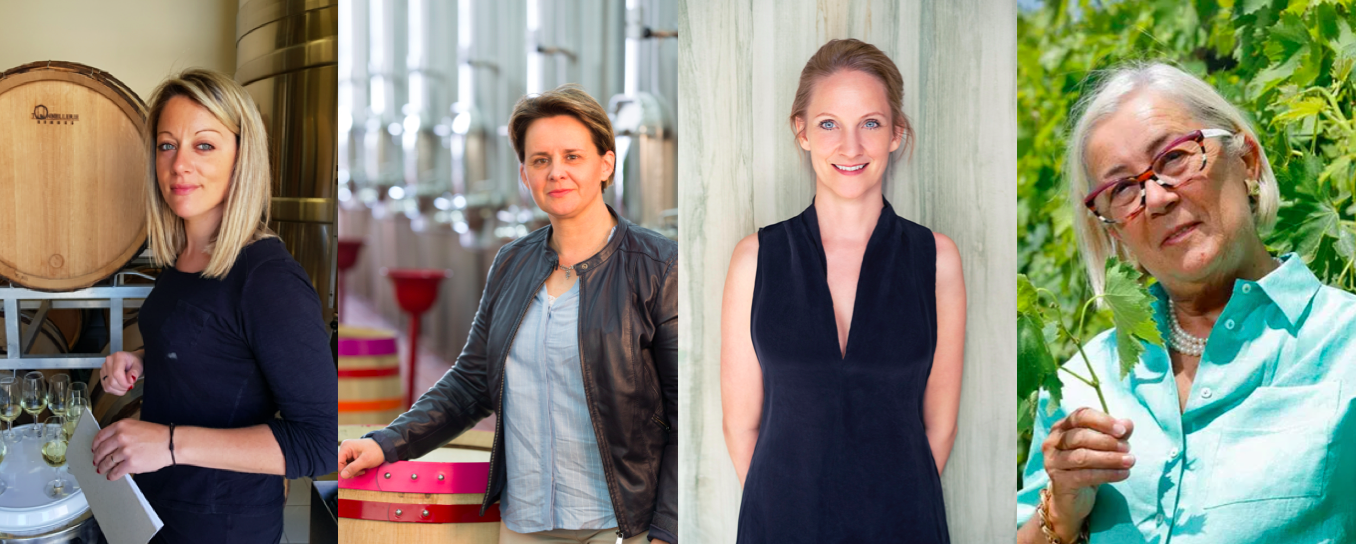 From left: Charlène Pinson, Florence Heresztyn-Mazzini, Eva Fricke, and Donatella Cinelli Colombini
From left: Charlène Pinson, Florence Heresztyn-Mazzini, Eva Fricke, and Donatella Cinelli Colombini
Charlène Pinson – Pinson
One of the longest-established families in Chablis, records show that the Pinsons have been producing in the region since 1640. Having joined her father, Laurent, at the estate in 2008, Charlène Pinson tells us of her respect for tradition and the work that her family has done before her, with the aim to “pass on the passion” to her two sons. Producing 13 different wines, she explains that each is a “reflection of their terroirs”, and are “more or less floral and fruity” depending on the slope and soil of the parcel. For those new to Pinson, she recommends the 2017 Chablis Mont de Milieu, describing it as a “pure expression of our Kimmeridgian limestones […] classic, mineral, balanced, and fresh”.
Florence Heresztyn-Mazzini – Heresztyn-Mazzini
Taking over her family’s estate (Domaine Heresztyn) in 2012, Florence Heresztyn-Mazzini and her husband, Simon Mazzini have overseen numerous developments under its new name. Introducing biodynamic practices in 2015, and achieving organic certification in 2019, Florence continues to “experiment with natural treatments” to fulfil her goal of “fighting the challenges of climate change”, including more “cover crops and sustainable pruning”. Explaining that many recent vintages have been difficult due to global warming, she tells us that she is particularly proud of her “fights” in 2013 and 2016, creating top quality wines in years that “remind us that we are small in the face of Mother Nature!”.
Eva Fricke – Eva Fricke
After making wine in Australia, Spain, and Germany, Eva Fricke returned to Germany in 2006 to start her own estate, which now holds 17ha across the Rheingau. Achieving organic certification in 2016 and membership in The Vegan Society in 2017, the property also employs several biodynamic practices including its adherence to the lunar calendar. She tells us that these principals guide her goals of developing a domain that “stands for organic, sustainable, and socially conscious standards”. Eva notes the “2019 Lorcher Schlossberg, 2019 Lorcher Krone Trocken, and 2019 Lorcher Krone Trockenbeerenauslese” as some of her top wines.
Donatella Cinelli Colombini – Casato Prime Donne and Fattoria del Colle
Born into a family of winemakers whose production in Montalcino can be traced back to 1592, Donatella Cinelli Colombini tells that it is “for this reason” that winemaking comes naturally to her. Founding Italy’s first winery run solely by women, she explains that her decision to have an all-female staff at Casato Prime Donne “leaves an imprint of acute accuracy in each step of the production process”. She notes of Casato Prime Donne wines that they are some of the first “chosen, and produced by women, for women”.
 Lafon-Rochet’s latest release is a “very successful 2020”, according to Wine Lister partner critic, Jancis Robinson
Lafon-Rochet’s latest release is a “very successful 2020”, according to Wine Lister partner critic, Jancis Robinson 









